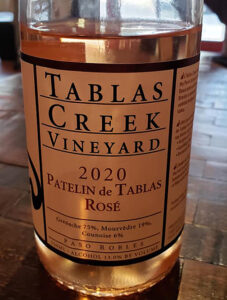Latest Review
2020 Tablas Creek, Patelin de Tablas Rosé, Paso Robles.
This Patelin de Tablas Rosé is one of the standard bearers of dry California Rosés and remains one of the tastiest in the state, it is made from 75% Grenache, 19% Mourvedre and 6% Counoise sourced from mostly non estate grown fruit, but all within the preferred westside zone with cool air from the Templeton Gap and the classic limestone spoils, which allows ripe flavors, but with vitality and a crisp form. The delicately pale, peachy/pink colored 2020 is immensely pleasing, lively and steely with tart cherry, strawberry, grapefruit, watermelon and nectarine flavors leading the way along with saline, mouth watering acidity, mineral notes, rosewater and wild herbs. While lean, bone dry and zesty, this Patelin de Tablas Rosé has a surprising roundness and is very palate generous, making for an impactful wine and wonderfully refreshing at only 13% natural alcohol. The grapes for the Patelin de Tablas Rosé, as the winery explains, are sourced from three Paso Robles appellations, all as mentioned on the westside, including the warmer, higher-elevation Adelaida District, near the Tablas Creek estate itself, and the moderate, hilly El Pomar to the south-east, that provide the structure in the wine, as well as the moderate-to-warm Creston area, east of Templeton, that produces grapes with loads of fruit and spice. Tablas Creek’s Rosé was one of the first serious dry Rosé wines in California and it continues to be one of the most tasty, though it now has lots of great competition now, from Bedrock’s Ode to Lulu to Arnot-Roberts’ Rosé of Touriga Nacional, to Niki Pallesen’s Stars & Dust Rosé, Tribute to Grace and Ian Brand’s Le P’tit Paysan Peirre’s Pirouette, to name just a few.
The Tablas Creek Vineyard Patelin de Tablas Rosé is mainly Grenache, similar to Tavel, the Rhone’s only all Rosé appellation and to parts of Provence like the area of Cassis, which this wine really reminds me of most, and is, as the winery notes, supplemented with Mourvèdre and Counoise to provide some deeper fruit tones and additional spice. The winery continues that 80% of the grapes were picked and direct-pressed into stainless steel tanks with no real skin contact, or maceration, beyond the time they spent in the press, while the remaining 20% grapes were picked cold, early in the morning or at night, then de-stemmed and left to cold soak for close to 8 hours to provide some color and structure. Going on the winery adds, that after 12 hours or there abouts, these macerating lots were pressed and then added to the direct-press lots to ferment. The fermentation was spontaneous, only using native yeasts and after primary fermentation the tanks were blended and cold-stabilized, with everything done to preserve freshness and purity, and the finished Rosé was bottled after about 3 months in tank. Tablas also produces a full on Saignee Rosé that is full bodied and much fruitier in style, that wine, the Dianthus, is much darker, picked later and comes from estate vines and is made of 48% Mourvedre, 37% Grenache and 15% Counoise, making more traditionally like a more powerful Bandol Rosé. Both are exceptionally delicious wines and both deserve your attention if you are looking for quality dry Rosé, though I personally seem to gravitate to this Patelin de Tablas version.
($25 Est.) 92 Points, grapelive
